With the blessing of mild weather recently, I had the chance to get back out and run through an orienteering/land navigation course at a local state park. Orienteering is essentially a competitive or noncompetitive recreational activity in which participants use a map and compass to navigate between check-points along an unfamiliar course (as in the woods). I was introduced to orienteering quite a while back in the military as it was a fundamental element of our training. FM 3-25.26 for all my fellow Army veterans reading this! I know there are plenty of smart watches and other handheld GPS devices that can accurately calculate your location and give you directions these days. But there is something about getting back to the basics of using only a map and compass that challenges you and gives you a sense of accomplishment.
While making my way through the course, I couldn’t help but think about some of the similarities between navigating your way through the woods and what most of us are navigating our way through almost every day at or away from work. For example, it’s critical that you know where you are on the map to start orienteering to your first check-point. You can have the most accurate compass telling you which direction to go but if you aren’t where you think you are on the map, you’ll never end up at your first check-point. While navigating through the woods, you will no doubt come across obstacles that don’t allow you to follow the straight path your compass told you to. In this case, you have to come up with a different solution and navigate around the obstacle to get back on course. And lastly, there will be steep hills that slow you down on one side and speed you up on the other side.
Clearly there is more to orienteering than what I noted above and even more similarities to what we all navigate through every day. While orienteering and the skills such as map reading and use of a compass may not necessarily help you with your day-to-day job, it does remind us all that getting back to the basics in this fast moving and rapidly changing world might not be a bad approach:
- Slow down and get the map out to determine your location (ground yourself).
- Use your compass (instinct, experience, logic, empathy) to determine the direction to the next check-point.
- Remember, there will always be two sides to a hill (tough side and an easy side).
- There is always a solution to get around an obstacle (Volatility, Uncertainty, Complexity, Ambiguity) and get back on course. The direct path may not always be the correct path.
If you haven’t had the opportunity to try orienteering, check out state parks in your area. Many of them have courses and even offer beginner classes. You may actually enjoy the challenge!

